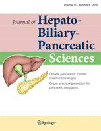The outcomes of methicillin-resistantStaphylococcus aureus infection after living donor liver transplantation in a Japanese center
Abstract
Objective
The objective of this study is to present results from our review of methicillin-resistantStaphylococcus aureus (MRSA) infection in living-donor liver transplant (LDLT) recipients.
Methods
Seventy patients with primary LDLT between August 1997 and May 2007 were retrospectively reviewed.
Results
Overall, 9 patients (12.9%) encountered various kinds of MRSA infection after transplantation [peritonitis (6), bacteremia (6), pneumonia (3), wound infection (3), cholangitis (1)]; 4 of these 9 patients died. Of these 4 expired patients, 3 were highly urgent cases with very poor pretransplant status under ventilator support. In one patient, linezolid was effective after teicoplanin failure for severe systemic MRSA infections (bacteremia, peritonitis, cholangitis, pneumonia, and enteritis). Of the 4 patients in whom MRSA was isolated only in a nasal swab before transplantation, none developed MRSA infection after transplantation with a 3-day course of mupirocin prophylaxis.
Conclusions
MRSA infection was a contributing factor in death after transplantation in cases with poor pretransplant status. Linezolid was effective even for treating systemic MRSA infection after LDLT. A short course of mupirocin prophylaxis seemed to be effective and did not have any adverse effects.




